1998 GMC SIERRA wheel
[x] Cancel search: wheelPage 22 of 452
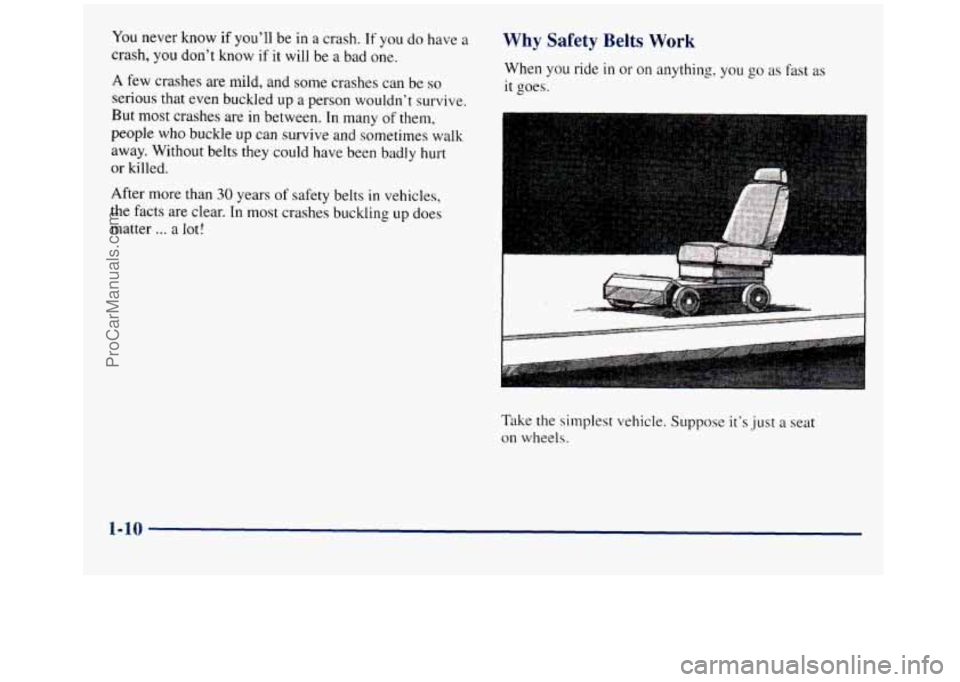
You never Know if you’ll be in a crash. If you do have a
crash, you don’t know if it will be a bad one.
A few crashes are mild, and some crashes can be so
serious that even buckled up a person wouldn’t survive.
But most crashes are in between. In many of them,
people
who buckle up can survive and sometimes walk
away. Without belts they could have been badly hurt
or killed.
Why Safety Belts Work
When you ride in or on anything, you go as fast as
it goes.
After more than
30 years of safety belts in vehicles,
the facts are clear. In most crashes buckling up does
matter
... a lot!
Take the
simplest vehicle. Suppose it’s just a seat
on wheels.
1-10
ProCarManuals.com
Page 35 of 452
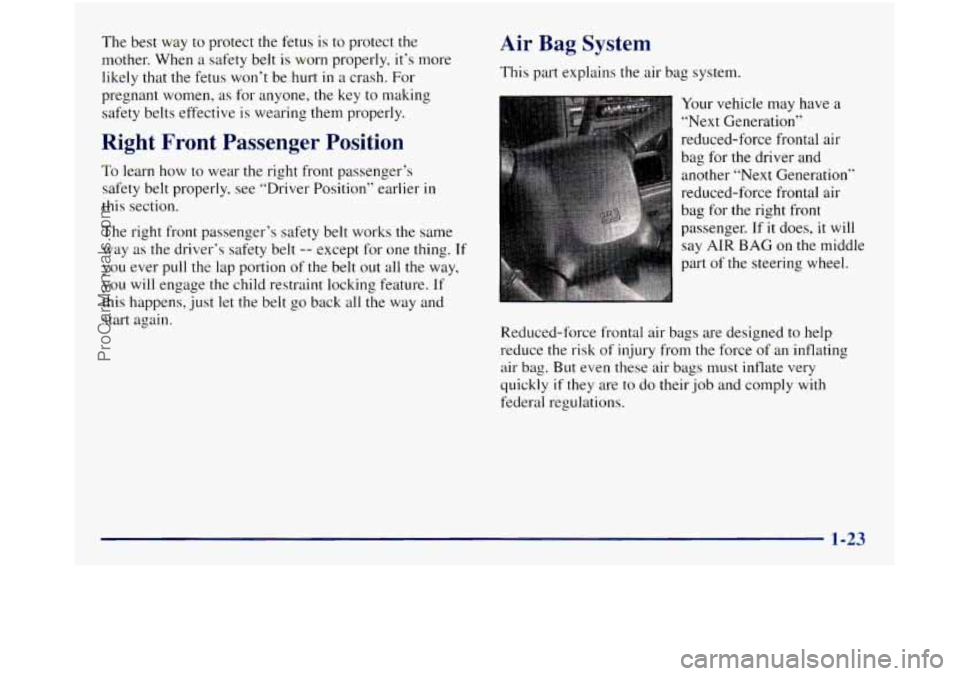
The best way to protect the fetus is to protect the
mother. When
a safety belt is worn properly, it’s more
likely that the fetus
won’t be hurt in a crash. For
pregnant women,
as for anyone, the key to making
safety belts effective
is wearing them properly.
Right Front Passenger Position
To learn how to wear the right front passenger’s
safety belt properly, see “Driver Position” earlier in
this section.
The right front passenger’s safety belt works the same
way as the driver’s safety belt
-- except for one thing. If
you ever pull the lap portion of the belt out all the way,
you will engage
the child restraint locking feature. If
this happens, just let the belt go back all the way and
start again.
Air Bag System
This part explains the air bag system.
Your vehicle may have a
“Next Generation’‘
reduced-force frontal air
bag for the driver and
another “Next Generation”
reduced-force frontal air
bag for the right front
passenger. If
it does, it will
say AIR BAG
on the middle
part
of the steering wheel.
Reduced-force frontal air
bags are designed to help
reduce the risk of injury from the force of
an inflating
air bag. But even these air bags must inflate very
quickly
if they are to do their job and comply with
federal regulations.
1-23
ProCarManuals.com
Page 38 of 452
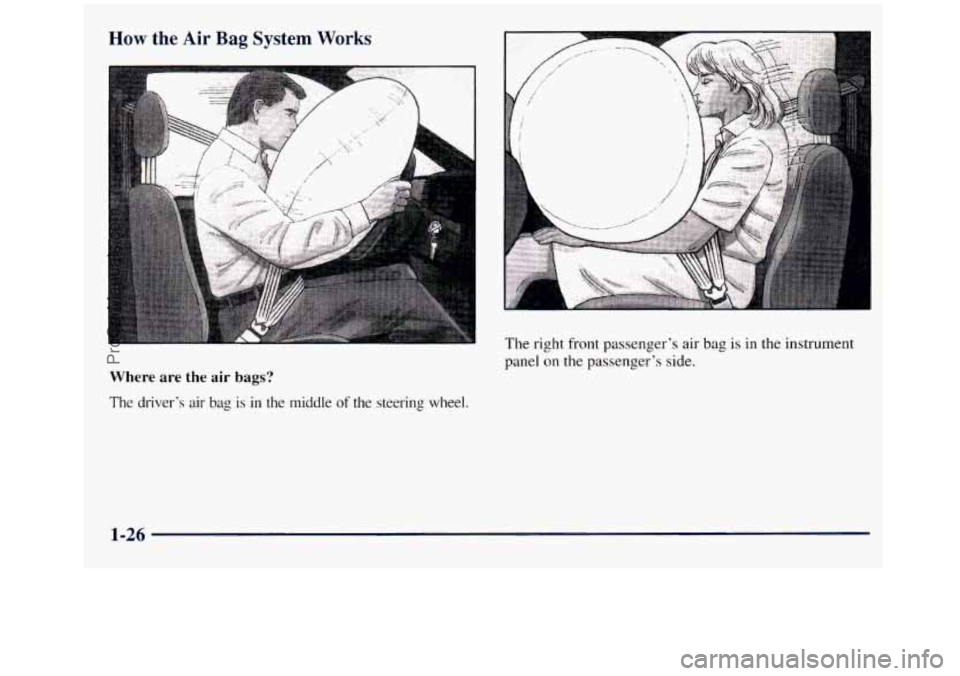
How the Air Bag System Works
Where are the air bags?
The driver’s air bag is in the middle of the steering wheel. The right front passenger’s air
bag
is in the instrument
panel
on the passenger’s side.
1-26
ProCarManuals.com
Page 39 of 452
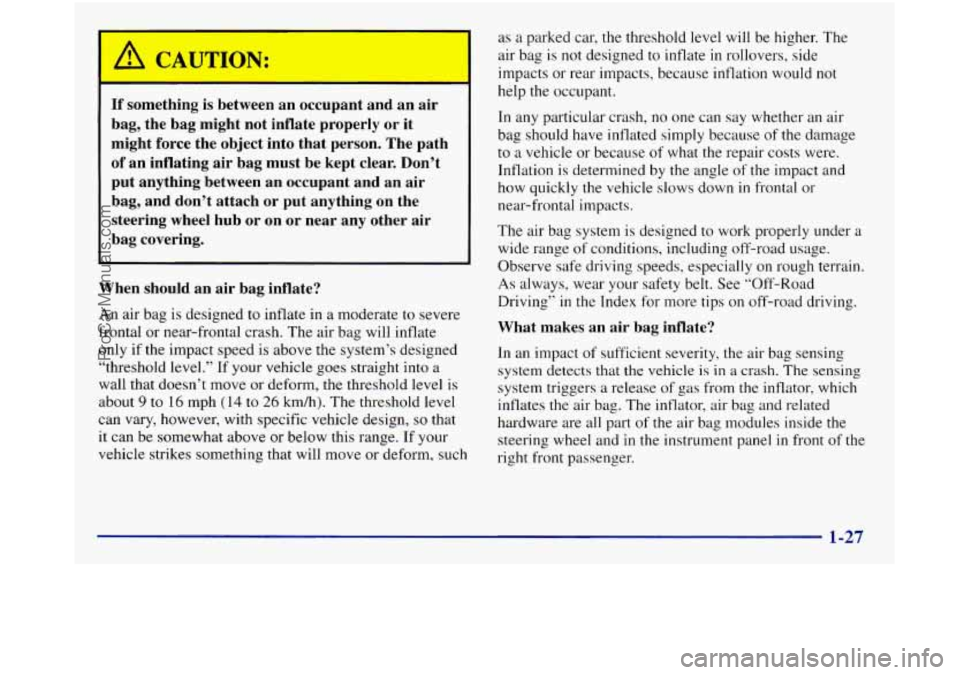
p, CAUTION:
If something is between an occupant and an air
bag, the bag might not inflate properly or it
might force the object into that person. The path
of an inflating air bag must be kept clear. Don’t
put anything between an occupant and an air
bag, and don’t attach or put anything on the
steering wheel hub or on or near any other air
bag covering.
When should an air bag inflate?
An air bag is designed to inflate in a moderate to severe
frontal or near-frontal crash. The air bag will inflate
only if the impact speed
is above the system’s designed
“threshold level.” If your vehicle goes straight into a
wall that doesn’t move or deform,
the threshold level is
about
9 to 16 mph (14 to 26 km/h). The threshold level
can vary, however, with specific vehicle design,
so that
it can be somewhat above or below this range. If your
vehicle strikes something that will move or deform, such as
a parked car, the threshold
level will be higher. The
air bag
is not designed to inflate in rollovers, side
impacts or rear impacts, because inflation would not
help the occupant.
In any particular crash,
no one can say whether an air
bag should have inflated simply because of the damage
to a vehicle or because of what the repair costs were.
Inflation is determined by the angle of the impact and
how quickly the vehicle slows down
in frontal or
near-frontal impacts.
The air bag system is designed to work properly under a
wide range
of conditions, including off-road usage.
Observe safe driving speeds, especially
on rough terrain.
As always, wear your safety belt. See ”Off-Road
Driving’‘
in the Index for more tips on off-road driving.
What makes an air bag inflate?
In an impact of sufficient severity, the air bag sensing
system detects
that the vehide is in a crash. The sensing
system triggers a release
of gas from the inflator, which
inflates
the air bag. The inflator, air bag and related
hardware are all part
of the air bag modules inside the
steering wheel and in the instrument panel
in front of the
right front passenger.
1-27
ProCarManuals.com
Page 40 of 452
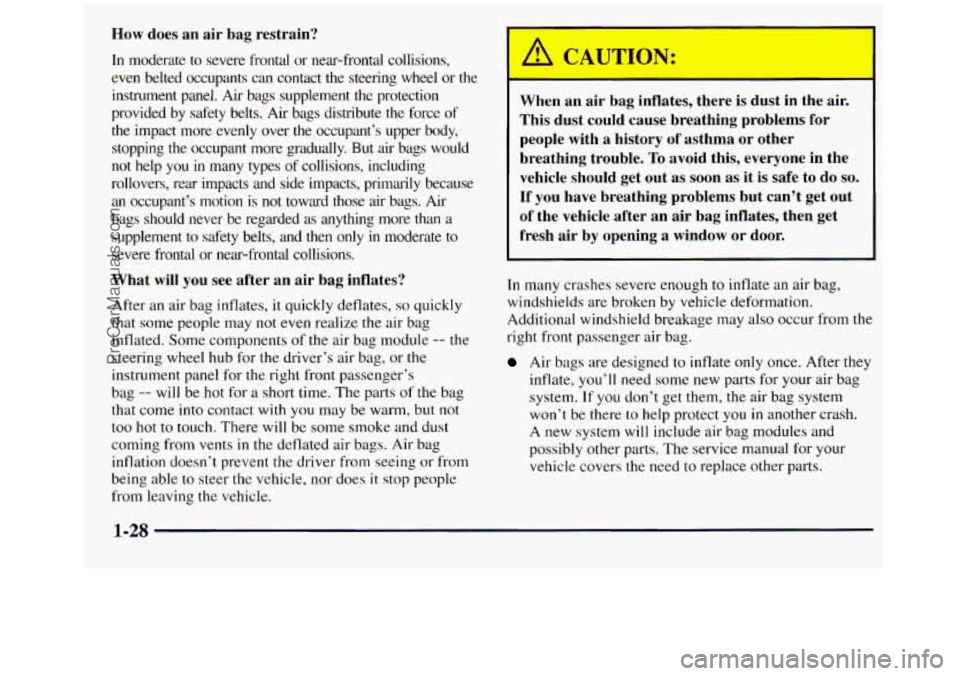
How does an air bag restrain?
In moderate to severe frontal or near-frontal collisions,
even belted occupants can contxt the steering wheel or the
instrument panel.
Air bags supplement the protection
provided by safety belts. Air bags distribute the force of
the impact more evenly over the occupant’s upper body,
stopping the occupant more gradually. But air bags would
not help you in many types of collisions, including
rollovers, rear impacts and side impacts, primarily because
an occupant’s motion is not toward those air bags. Air
bags should
never be regarded as anything more than a
supplement to safety belts, and then only
in moderate to
severe frontal or near-frontal collisions.
What will you see after an air bag inflates?
After an air bag inflates, it quickly deflates, so quickly
that some people may not even realize the air bag
inflated. Some components of the air bag module
-- the
steering wheel hub for the driver’s air bag, or
the
instrument panel for the right front passenger’s
bag
-- will be hot for a short time. The parts of the bag
that come into contact with
you may be warm, but not
too hot to touch. There will be some smoke and dust
coming from vents
in the deflated air bags. Air bag
inflation doesn’t prevent the driver from seeing or from
being able to steer
the vehicle, nor does it stop people
from leaving the vehicle.
When an air bag inflates, there is dust in the air.
This dust could cause breathing problems for
people with a history of asthma or other
breathing trouble,
To avoid this, everyone in the
vehicle should get out as soon as it
is safe to do so.
If you have breathing problems but can’t get out
of the vehicle after an air bag inflates, then get
fresh air by opening
a window or door.
In many crashes severe enough to inflate an air bag,
windshields are broken by vehicle deformation.
Additional windshield breakage may also occur from the
right front passenger air bag.
Air bags are designed to inflate only once. After they
inflate,
you’ll need some new parts for your air bag
system.
If you don’t get them, the air bag system
won’t be there to help protect you
in another crash.
A new system will include air bag modules and
possibly other parts. The service manual for your
vehicle covers the need to replace other parts.
ProCarManuals.com
Page 42 of 452

I NOTICE:
If you damage the covering for the driver’s or the
right front passenger’s air bag, the bag may not
work properly. You may have to replace the air
bag module in the steering wheel or both the air
bag module and the instrument panel for the right front passenger’s air bag.
Do not open or
break the air bag coverings.
Servicing Your Air Bag-Equipped Vehicle
Air bags affect how your vehicle should be serviced.
There are parts
of the air bag system in several places
around your vehicle. You don’t want the system to
inflate while someone is working on your vehicle. Your
dealer and the service manual have information about
servicing your vehicle and the air
bag system. To
purchase a service manual, see “Service and Owner
Publications”
in the Index.
If your vehicle ever gets into a lot of water -- such as
water up to the carpeting or higher -- or if water enters
your vehicle
and soaks the carpet, the air bag controller
can be soaked and ruined. If this ever happens, and then
you start your vehicle, the damage could make the air
bags inflate, even if there’s no crash.
You would have to
replace the air bags
as well as the sensors and related
parts. If your vehicle is ever
in a flood? or if it‘s exposed
to water that soaks the carpet, you can avoid needless
repair costs
by turning off the vehicle immediately.
Don’t
let anyone start the vehicle, even to tow it, unless
the battery cables are first disconnected.
I
For up to 10 minutes after the ignition key is
turned off and the battery is disconnected, an air
bag can still inflate during improper service. You
can be injured if you are close to an air bag when
it inflates. Avoid
wires wrapped with yellow tape
or yellow connectors. They are probably part of
the
air bag system. Be sure to follow proper
service procedures, and make sure the person
performing work for you
is qualified to do so.
~~
The ail- bag system does not need regular maintenance.
1-30
ProCarManuals.com
Page 85 of 452

Section 2 Features and Controls
Here you can learn about the many standard and optional features on your vehicle, and information on starting,
shifting and braking. Also explained are the instrument panel and
the warning systems that tell you if everything is
working properly
-- and what to do if you have a problem.
2-2
2-
3
2-4 2-5
2-6
2-9
2-
10
2- 10
2-1 1
2-12
2- 14
2-15
2-18
2-2
I
2-25
2-26
2-29 Keys
Tailgate
Third Door
(If Equipped)
Door Locks
Keyless Entry System (If Equipped)
Theft
PasslockTM
New Vehicle ”Break-In”
Ignition Positions
Starting Your Gasoline Engine
Engine Coolant Heater (If Equipped) Automatic Transmission Operation
Manual Transmission Operation Four-wheel Drive
(If Equipped)
Parking Brake
Shifting Into Park
(P) (Automatic
Transmission Models
Only)
Shifting Out of Park (P)
(Automatic Transmission) 2-29
2-30
2-30
2-3 1
2-32
2-32
2-34
2-35
2-4
1
2-43
2-45
2-5
1
2-60
2-62
2-64 Parking
Your Vehicle (Manual Transmission
Models
Only)
Parking Over Things That Burn
Engine Exhaust
Running Your Engine While You’re Parked
(Automatic Transmission)
Locking Rear Axle (If Equipped)
Windows
Tilt Wheel (If Equipped)
Turn Signal/Multifunction Lever
Exterior Lamps
Interior Lamps Mirrors
Storage Compartments
Instrument Panel
Instrument Panel Cluster
Warning Lights, Gages and Indicators
ProCarManuals.com
Page 93 of 452

Synchronization
Synchronization may be necessary d~te to the security
method used by this system. The transmitter does not
send the
same signal twice to the receiver. The receiver
will not respond to a signal it has been sent previously.
This prevents anyone from recording and playing back
the signal
from the transmitter.
To resynchronize your transmitter, stand close to your
vehicle and simultaneously press and hold the
LOCK
and UNLOCK buttons on the transmitter for at least
five seconds. The door locks should cycle to confirm
synchronization.
If the locks do not cycle. see your
dealer for service.
Theft
Vehicle theft is big business, especially in scme cities.
Although your vehicle has
a number of theft-deterrent
features, we know that nothing we put on
it can make it
impossible to steal. However. there are ways you can help.
Key in the Ignition
If you leave your vehicle with the keys inside, it's an
easy target forjoy riders
01- professional thieves -- so
don't do it.
When you park your vehicle and open the driver's door,
you'll hear
a tone reminding you to remove your key
from the ignition and take
it with you. Always do this.
Ycx~r steering wheel will be locked, and so will your
ignition.
If you have an automatic transmission, taking
your key
out also locks your transmission. And
remember
to lock the doors.
Parking at Night
Park in a lighted spot, close all windows and lock your
vehicle. Remember
to keep your valuables out of sight.
Put them in a storage area, or take them with you.
Parking Lots
If you park in a lot where someone will be watching
your vehicle, it's best to lock
it up and take your keys.
But what if you have to leave your ignition key? What if
you have to leave something valuable in your vehicle'?
Put your valuables in a storage area, like your
glove box.
Lock all the doors except the driver's.
2-9
ProCarManuals.com